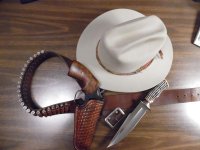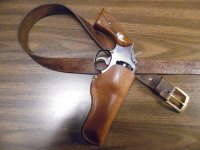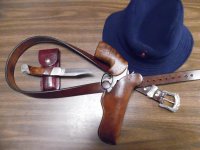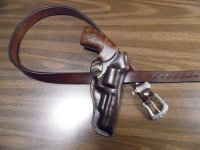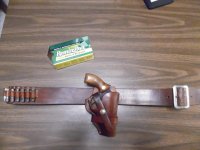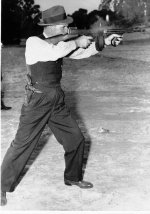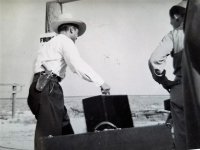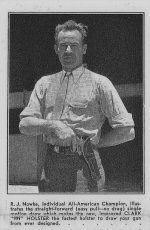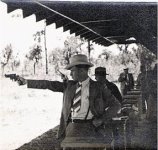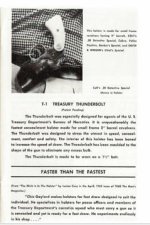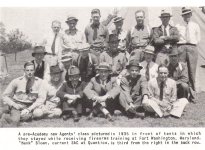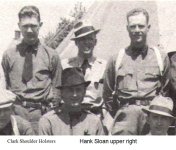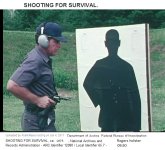My collection is little, but growing. Below left to right as follow:
Myres #614 Tom Threepersons style. Very popular with Agents.
Authorized but not issued. They had to buy their own. On a
Carson Ranger belt, Solingen blade, & USAFSS cap. Notice the
front of the trigger guard on my model 29 with 4" barrel is not
resting on the welt as it should be. Why? The holster was made
for a 3.5" N Frame magnum.
Lawrence 34B FBI style "extra quick draw". The B is for basket
stamped. Lawrence also made some beautiful floral carved which
was 34F. Lawrence FBI models came along later than the others.
I don't know if they were authorized or not. If anyone knows,
let me know. Shown on a Lawrence cartridge belt. The knife
is Sharp's Bowie. And my Stetson.
Crump holsters were issued by the FBI. In the early 1950s a
new agent would have a choice. A S&W M&P or Colt's OP.
Holsters by Crump or Heiser (provided through Evaluators)
were issued. On an old floral stamped belt.
Heiser pre-457. I call it a pre because there is no 457 mark on
it. It is the older HHH logo, and identical to the 457 which came
along a little later. The belt is by Simply Rugged. The knife is
a Junkyard Dog II by Kershaw. My USAF Vet. Cap.
Heiser 459. By the early 1950s holsters with hammer protector,
from Heiser and Crump were being issued. The hammer spur on
the Agent's revolver would shred the lining of their suit jacket,
so the protector was the answer. The famous thirty dollar belt,
that I spruced up with a buckle set. Bear knife & Boonie hat.
Myres #614 Tom Threepersons style. Very popular with Agents.
Authorized but not issued. They had to buy their own. On a
Carson Ranger belt, Solingen blade, & USAFSS cap. Notice the
front of the trigger guard on my model 29 with 4" barrel is not
resting on the welt as it should be. Why? The holster was made
for a 3.5" N Frame magnum.
Lawrence 34B FBI style "extra quick draw". The B is for basket
stamped. Lawrence also made some beautiful floral carved which
was 34F. Lawrence FBI models came along later than the others.
I don't know if they were authorized or not. If anyone knows,
let me know. Shown on a Lawrence cartridge belt. The knife
is Sharp's Bowie. And my Stetson.
Crump holsters were issued by the FBI. In the early 1950s a
new agent would have a choice. A S&W M&P or Colt's OP.
Holsters by Crump or Heiser (provided through Evaluators)
were issued. On an old floral stamped belt.
Heiser pre-457. I call it a pre because there is no 457 mark on
it. It is the older HHH logo, and identical to the 457 which came
along a little later. The belt is by Simply Rugged. The knife is
a Junkyard Dog II by Kershaw. My USAF Vet. Cap.
Heiser 459. By the early 1950s holsters with hammer protector,
from Heiser and Crump were being issued. The hammer spur on
the Agent's revolver would shred the lining of their suit jacket,
so the protector was the answer. The famous thirty dollar belt,
that I spruced up with a buckle set. Bear knife & Boonie hat.
Attachments
Last edited:


